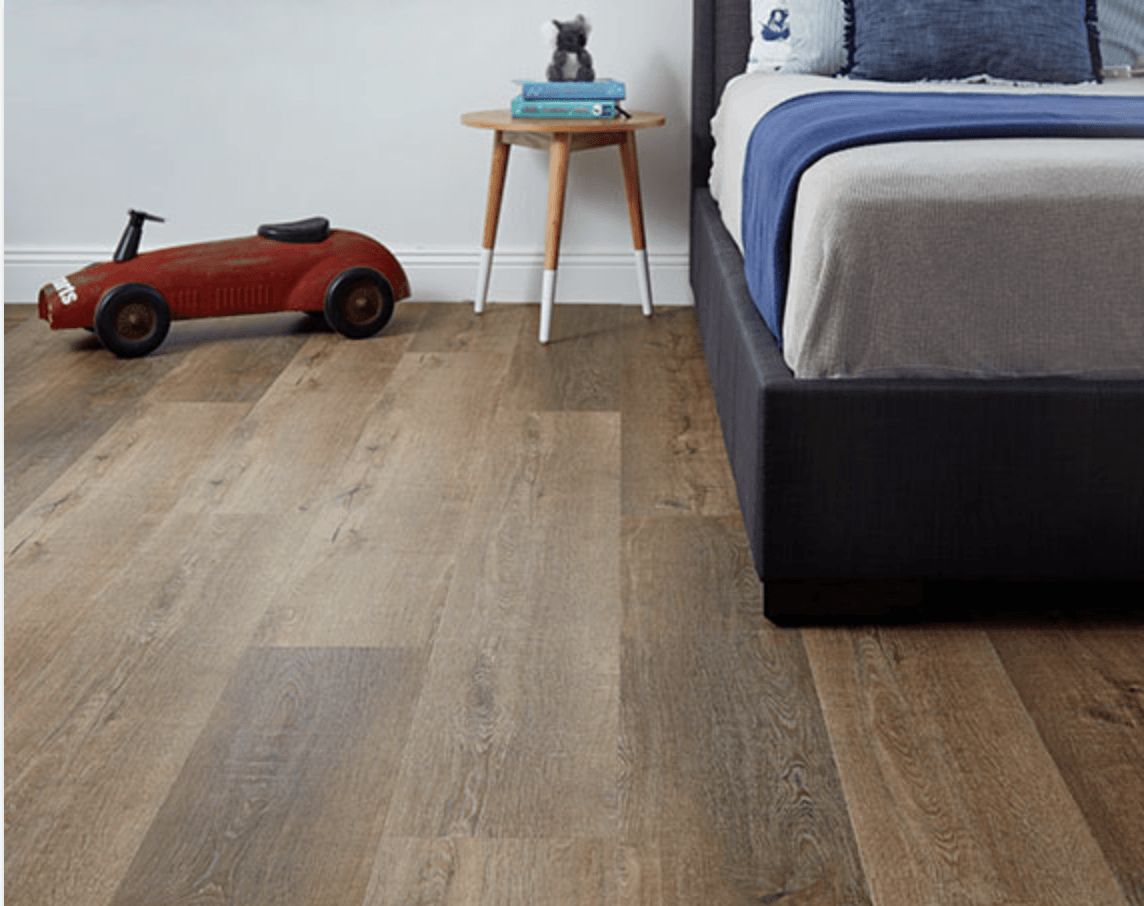

04 Mar The Complete Guide to Choosing a Floor
How to Choose Flooring
You know you need a new floor, but you may not know where to start. There are probably many questions on your mind, such as:
- “Which one is the best?”
- “Can I afford it?”
These questions probably sound familiar. Choosing the best floor for your home can be confusing. In fact, there’s no such thing as the absolute “best” floor.
The best floor for you is different from the best floor for someone else, so focus on finding the best floor for your individual needs.
Don’t worry—this guide simplifies your decision-making process and highlights the key factors to consider when choosing a floor.
Here are the different types of floorboards to choose from:
- Engineered Floorboards
- Timber Floorboards
- Laminate Floorboards
- Bamboo Floorboards
- Hybrid Floorboards
- Floating Floorboards
I’ve split this guide into three sections. First, each floor type with pros and cons. Second, the five most important pre-purchase considerations. Finally, a comprehensive comparison table across all key dimensions.
I’m confident this guide will arm you with everything you need to choose the best flooring option for your needs—you might even become a mini flooring expert along the way.
I hope you enjoy this guide and that it helps you choose the best and most beautiful floor for your home.
Gordon Zhang
Founder & Director, FloorVenue
20+ years of flooring experience
Types of Flooring
Firstly, let’s go over the different types of flooring that could be suitable for your home. The term “timber flooring” is often used to group all “wood-like” flooring, but most of those aren’t 100% real timber. Entering the 2020s, the majority of flooring on the market are non-timber and bring additional benefits. In this guide, “timber flooring” refers only to 100% real wood flooring.
Below is a balanced overview of each floor type so you can make an informed decision.
Solid Timber (Hardwood) Flooring
Solid timber flooring (hardwood) has accompanied homes for generations. It is made from real timber, showcasing natural grain and warmth. Because it’s natural wood, colour ranges are more limited than man-made options.
Two variants:
- Raw — installed first, then finished on site (sanded, stained, coated). Offers the highest customisation and a smooth, bevel-free finish.
- Prefinished — factory finished (sanded, stained, coated) and ready to install; more convenient.
PROS
- Authentic, traditional real wood
- Can last a lifetime with proper care
- Ages beautifully over time
- Warm, natural underfoot feel
CONS
- Most expensive category
- Periodic refinishing needed to remove scratches/marks
- Not suitable for wet areas
- More complex install (glue and nail to subfloor)
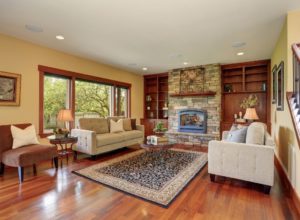

Laminate Flooring
Laminate flooring is a high-resolution decorative print laminated onto wood-composite layers. It can convincingly mimic timber, oak, bamboo and many designer looks—hence the broad variety.
PROS
- Replicates the look of timber and designer styles
- High durability against dents and scratches
- Affordable; simple floating installation
- Stable colour with minimal natural variation
CONS
- Not real timber
- Not for very wet zones (e.g., bathrooms)
- Less natural feel than real wood
- Low-quality products may emit VOCs
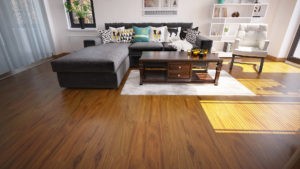

Hybrid Flooring
Hybrid flooring blends the strengths of vinyl and laminate into an improved floating floor. Layers typically include a UV wear layer, decorative film, a waterproof/stable composite core, and an acoustic backing.
Two core types:
- SPC (Stone Plastic Composite) — thinner, denser, generally more affordable.
- WPC (Wood Plastic Composite) — thicker, slightly softer underfoot, generally pricier.
PROS
- 100% waterproof
- Highly durable in high-traffic areas
- Colourfast over time
- Affordable, DIY-friendly floating install, low maintenance
CONS
- Man-made; lacks full authenticity of real timber
- Less natural tactile feel
- May feel less solid than thicker board constructions


Engineered Flooring
Engineered flooring is a layered timber product with a prefinished real-wood top layer bonded to plywood layers beneath. Common categories include Engineered Hardwoods and Engineered Oak. It delivers real-timber appeal with floating-floor versatility—great for apartments.
PROS
- Real timber look and feel
- More dimensionally stable than solid timber
- Suitable for apartments
- Easier to install than solid timber
CONS
- Can be expensive (premium ranges approach solid timber pricing)
- Thin top layer limits future sanding/polishing
- Timber top layer can be prone to surface wear
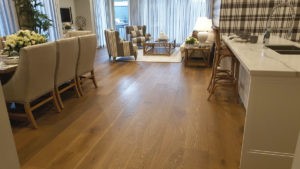

Bamboo Flooring
Bamboo floors are made from fast-growing bamboo and can be harder than many timbers. Processed under heat and pressure, bamboo offers natural beauty, durability, and eco-credentials.
Common constructions:
- Strandwoven — interlocked fibres for maximum strength; most premium.
- Horizontal — boards laminated horizontally; wider grain look.
- Vertical — boards laminated vertically; narrower grain look.
PROS
- Real bamboo material
- More affordable than solid timber
- Environmentally friendly
- Apartment-friendly floating installation
CONS
- Not for very wet zones
- More responsive to temperature/humidity changes
- Less colour/style variety
- Potential VOCs depending on manufacture
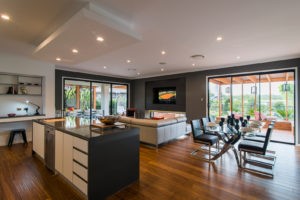

Key Considerations
Now that you understand the “timber” and “timber-like” options, keep these points in mind before deciding.
Type of Property
Where will the floor go? Home or commercial? How long will you stay?
Residential — lower foot traffic, no stilettos, more floor care. You have a wide range from premium solid timber to economical laminate.
- Personal home — pick the floor that suits your comfort and budget.
- Renting out — lean toward durable, affordable man-made floors (laminate, hybrid, bamboo).
- Short vs long term — short: budget options (laminate/hybrid/bamboo). Long: consider all, incl. solid timber and engineered.
Commercial — offices/showrooms/warehouses face heavy traffic. Prioritise durability and ROI: laminate, vinyl, and hybrid are strong candidates.
Foot Traffic Rule of Thumb
- High traffic — durable synthetics (hybrid, vinyl, laminate) with low maintenance.
- Low traffic — natural timber/engineered or synthetics can all work.
Budget
Flooring is a significant investment. Price varies by material, installation, and maintenance.
- Material — real timbers (hardwood, oak, bamboo) cost more; man-made (laminate, hybrid, vinyl) cost less. Timber species also vary in price.
- Installation costs — floating floors are simpler/cheaper than solid timber (nail & glue). Typical installation ranges $25–$80/sqm.
- Maintenance costs — timber may need sanding/polishing every 10–15 years (~$30–$40/sqm). Laminate/hybrid don’t need resurfacing; individual boards can often be replaced.
See the table below for a quick budget view. For deeper detail, read our Ultimate Flooring Cost Guide.
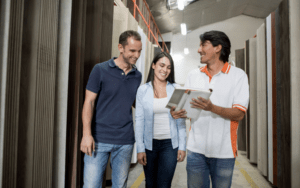

Moisture
Water is hazardous for most floors. Wet areas (kitchens, basements, bathrooms) need water-resistant choices.
- Bathrooms — tiles only (fully waterproof).
- Kitchens — hybrid and vinyl are good. Some premium laminates have water-resistant cores and wax-sealed edges. Follow Australian Standard AS 3740 for waterproofing in wet areas; we’ll recommend compliant products and installation.
Natural timber and engineered timber are more moisture-sensitive; many laminates also have lower water resistance.


Installation
DIY or professional? Floating floors (engineered, laminate, hybrid) are simpler than solid timber (glued and nailed). DIY may void some brand warranties—check first.
- Type of floor — indicative install costs (2021):
Timber $40–$80/sqm; Engineered $30–$40/sqm; Laminate $25–$30/sqm; Hybrid $25–$30/sqm; Vinyl $25–$40/sqm. - Subfloor condition — uneven subfloors must be corrected. Per AS 1884, variation should not exceed 2mm over 2m for resilient/floating floors. Our installers level to ensure compliance before laying.
- Area complexity — stairs, doors, wardrobes add time/skill, increasing costs.
Considering DIY? Use our step-by-step Guide to Installing Floating Flooring.


Maintenance
All hard floors need less upkeep than carpet, but requirements vary:
- Higher maintenance — solid/engineered timber (prone to surface scratching/denting); may need periodic re-sand & polish.
- Lower maintenance — laminate, hybrid, vinyl (durable wear layers).
Flooring Comparison Table
If you’ve read this far, here’s a quick summary:
| Type of Floor | Durability | Water Resistance | Apartment Suitability | Installation | Market Price (inc. installation) |
|---|---|---|---|---|---|
| Solid Timber | Medium–High | Low–Medium | Sometimes | Complex | Expensive ($120–$180/sqm) |
| Hybrid & Vinyl | High | High | Yes | Simple | Affordable ($55–$70/sqm) |
| Laminate | High | Low–Medium | Yes | Simple | Affordable ($40–$75/sqm) |
| Engineered Timber | Medium | Low–Medium | Yes | Simple | Moderate ($100–$150/sqm) |
| Bamboo | High | Low–Medium | Yes | Simple | Affordable ($65–$85/sqm) |
| Tiles | High | High | Sometimes | Complex | Moderate ($80–$140/sqm) |
Note: Ranges are indicative and can vary by brand, spec, and site conditions.
So What Do I Choose?
It depends on you—there’s no single right answer. Revisit the key considerations above and weigh each floor type against your needs. If you want tailored advice, contact FloorVenue’s expert team. We can guide your options and provide a free on-site measure and quote to ensure your new floor suits your home perfectly.
About FloorVenue
FloorVenue is NSW’s leading supplier and installer of beautiful, high-quality flooring. We’ve helped thousands of families and numerous builders, construction companies, and businesses.
We began humbly—our first “warehouse” was a garage. From wholesaling to retail and installation, our origins help us deliver premium floors at great value.
Our mission is to provide outstanding value and care. We hope to support your flooring journey.
Ready to start? Explore our full range of timber, laminate, hybrid, bamboo, and vinyl floors, or call today to speak with a FloorVenue flooring specialist for personalised recommendations.
Gordon Zhang
Founder & Director, FloorVenue




























